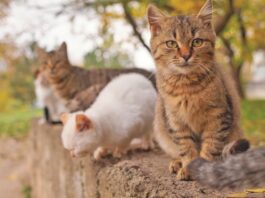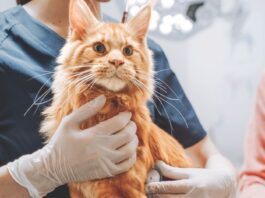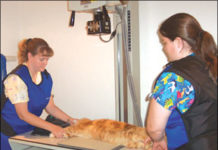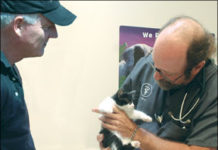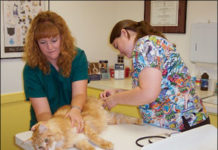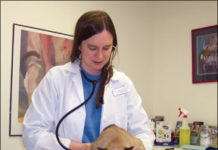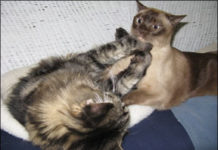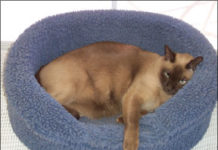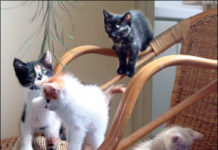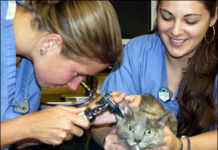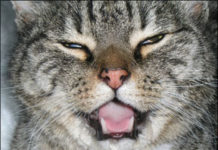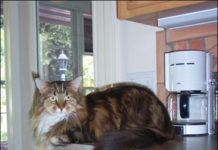The Musculoskeletal System
A healthy cats uniquely stunning physical traits - its power, agility and lightning-fast responses to external stimuli - are essentially attributable to its musculoskeletal system. In one way or another, this system is in operation 24 hours a day, whether a cat is hunting prey, escaping from predators, eating, drinking, napping, toying intently with a ball of yarn or digging its claws into your favorite piece of furniture. Unfortunately, cats are subject to a veritable host of disorders that can impair or totally impede the smooth operations of this impressively complex array of bones, muscles, tendons, ligaments and other tissues. Owners should be aware of the systems basic structure, various functions, and signs of its impairment, such as a noticeably altered gait, an apparent weakness in the joints, and the inability to chew and swallow food easily. As is the case with other feline disorders, says Christine Bellezza, DVM, a consultant at Cornell Universitys College of Veterinary Medicines Feline Health Center, early recognition and diagnosis of a cats musculoskeletal disorder are likely to improve the chances for its successful treatment.
Short Takes: 11/08
A recent report in the Journal of the American Veterinary Medical Association provided encouraging reassurance that lessons were learned from the tragic melamine contamination of pet food in 2007. Several of the investigators in the study "Clinicopathologic, histologic, and toxicologic findings in 70 cats inadvertently exposed to pet food contaminated with melamine and cyanuric acid" (JAVMA Vol. 233, No. 5) were from Cornell, where the New York State Animal Health Diagnostic Center did some of the groundwork that led to the largest recall of cat and dog food in U.S. history. The 70 cats in this study were not privately owned, nor were they laboratory cats that were deliberately fed suspect food to see if theyd get sick. Rather, they were 70 animals (from a licensed commercial cattery) that happened to be engaged in scientific diet-preference studies when the melamine contamination problem hit the national news. It was their good luck, however, to be where expert veterinary medical care was immediately at hand.
Dealing With Diabetes
Most affected cats will require dietary change and daily insulin injections, but overall its a highly treatable condition. Heres help.
The Feline Intestinal Tract
Of all feline health problems, intestinal disorders rank among those most frequently treated by veterinarians at local clinics and large referral hospitals throughout the U.S. According to Melanie Craven, BVM, an internist and researcher in gastroenterology at Cornell Universitys College of Veterinary Medicine, vomiting, diarrhea and dramatic weight loss are the most common signs of feline intestinal disease in cats. However, she notes, subtler signs such as lethargy and appetite fluctuations can also suggest the presence of an intestinal disorder. Some of these disorders may be secondary to conditions originating in other organs, such as the thyroid gland, liver, kidneys and pancreas. But, Dr. Craven points out, the problems usually originate in either the upper or lower segments of a cats intestines - the pliable, circuitous tunnel leading from an animals stomach to its anus.
Short Takes: 09/08
While the world holds its breath to see if the highly pathogenic avian flu virus H5N1 mutates enough to spread from person to person, German scientists wondered if the average house cat could have a role. An article in the Journal of Feline Medicine and Surgery (Vol. 10 Issue 4: "Prevalence of influenza H5N1 virus in cats from areas with occurrence of highly pathogenic avian influenza in birds"), gave the results of surveys that covered 171 cats in Austria and Germany. The study was presented "to learn more about the role of cats in the spread of the virus and about the risk posed to cats." They were looking for a good "sentinel" animal among mammals, to give an early warning - the way caged canaries in coal mines used to warn of poisonous gases.
Abscesses: Signs of Trouble
For several days, your good old cat has been acting oddly, lolling about the house, uncharacteristically lethargic, off his food and seemingly depressed. Then one evening, while stroking his back to comfort the mysteriously dispirited animal, you notice a smallish but alarming lump just to the side of his tail. Although you touch the lump ever so gently, he reacts with a howl, hisses, leaps from your lap and scurries to a dark corner. The lump you discovered is quite possibly an abscess, and although your touching it caused the poor animal intolerable discomfort, its a good thing that you spotted it. The sensitive swelling may indicate that the cat has an infection of some sort, which would explain his sluggish behavior of late, and prompt veterinary care is in order.
Ask Elizabeth: 08/08
Hmm, if I had known about this disease during my days on the farm, I might not have been so keen on eating birds myself! Songbird fever is an uncommon disease of cats, that results from eating Salmonella-infected birds or from spending time in bird feeding areas (and ingesting contaminated bird feces). Symptoms of songbird fever appear suddenly two to four days after exposure, last two to seven days, and include high fever, anorexia, depression, diarrhea (which may contain blood) and vomiting. The diagnosis can be confirmed by bacterial culture of the feces or blood. Songbird fever is fatal in up to 10 percent of cases.
Short Takes: 07/08
Theres more finger-pointing toward pets as "reservoirs" of MRSA, the hard-to stop bacterium methicillin-resistant Staphylococcus aureus. This time the New England Journal of Medicine (Vol. 358, No. 11) reports on a German woman who suffered deep abscesses and necrotizing pneumonia. The womans cat seemed healthy enough - until tests found the pet infected with a form of MRSA that is extremely rare in humans, spa-type t131 MRSA. Doctors at the Bavarian Food and Health Safety Authority said: "The abscesses in our patient healed only after antibiotic treatment of the cat. It remains unclear whether the cat was the source of the patients infection or vice versa . . . We conclude that pets could be considered as possible household reservoirs of MRSA that can cause infection or reinfection in humans."
The Threat of Panleukopenia
Among all agents of feline illness and mortality, few if any are more pernicious - especially to kittens - than feline panleukopenia virus (FPV). Disease resulting from infection with this virus is called panleukopenia - from the Greek words for all types (pan) of white blood cells (leuko) that are greatly reduced in number (penia). The disease is also known in some circles as "distemper," a misnomer, notes Fred Scott, DVM, PhD, a professor emeritus of virology in Cornell Universitys College of Veterinary Medicine and founding director of the Cornell Feline Health Center. "Distemper" refers to a respiratory disease, he explains, and there is no respiratory component to feline panleukopenia. Cats become infected with FPV - which is classified as a parvovirus - by living in an environment that is contaminated with it or by coming in contact with the urine, feces, saliva or nasal secretions of a cat that is already infected. "Panleukopenia is highly contagious," says Dr. Scott. "It takes only a small amount of the virus to cause infection, and the amount of virus shed by an infected cat is tremendous - probably anywhere from one billion to 10 billion viral particles per gram of fecal matter, urine or other secretions."
Diagnosis: Otitis Externa
Among all acquired feline ear disorders, the most common by far is otitis externa, an infection of the outer ear canal that, if untreated, can progress to the inner ear, damage the ear drum and seriously compromise an animals hearing as well as its sense of balance. The most common cause of this unpleasant condition and its potentially deafening consequences is an assault on the ear by an outside invader, the ear mite. In some cases, however, the culprit is an organism that normally resides harmlessly within a cats ear - a one-celled fungus, or yeast, known as Malessezia.
When Your Cat Pants
Your cat bounds up the stairs as usual. But when she gets to the top, she sits and pants - certainly not the usual. Should you worry, wait and see if she does it again or call your veterinarian immediately? In general, cats dont pant as dogs do. Dogs pant to cool themselves off, and its normal. While some cats pant from stress, pain or excitement, panting isnt usually normal for a cat, and you should probably consider taking action if it happens. What exactly is panting? Panting differs from regular breathing. Normal inhalation is an easy movement of the chest outward, with exhalation pulling the chest gently inward. Exhalation usually lasts three times longer than inhalation. The result is that entering air goes deep inside the lungs, where there is an exchange of oxygen and carbon dioxide via the blood vessels.
Short Takes: 04/08
Its one of the toughest choices a pet owner can face - between life-saving treatment and quality of life for the pet. During chemotherapy for lymphoma, the third most common form of cancer in cats, for example, the patient might lose hair, appetite, weight, sleep or even its whiskers. Some help in deciding, if the difficult time ever comes, can be found in a Journal of Feline Medicine and Surgery (Vol. 10, Issue 1) report: "Owners perception of their cats quality of life during chemotherapy for lymphoma." Of the 31 cat owners queried for the study, 25 (81 percent) said they were happy that they had treated their cat with chemotherapy, whereas three felt regretful and three were unsure of their feelings. Most of the owners (19) reported that their cats had "more good days than bad" during chemo; seven reported more bad days than good (including one cat that was miserable every day of the treatment); and four cats had "all good days." Despite the treatment, some cats did die of lymphoma or related causes. Obviously those owners were not happy with their pets eventual fate, but few regretted trying their best to save a life.


